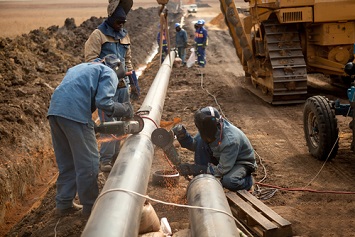America’s pipelines are integral to our economy, supplying the country with the crude oil and gas that fuels our businesses and day-to-day activities. But while the pipeline industry may be among the most important of our country’s industries, without awareness, training, and staunch commitment to safety regulations, pipeline work can also be among the riskiest.
With over 2.7 million miles of pipeline in the United States alone—much of it over 40 years old—safety in the pipeline industry should be a priority for every worker. Those in leadership roles particularly have a duty to ensure pipeline safety regulations are being followed and to instill a deep appreciation for safe practices in all workers.
Promoting a culture of safety involves training employees for potential incidents, identifying hazards, and making sure all are encouraged to take an active role in protecting themselves and others from harm. We share seven ways leaders can raise the standard for worker safety in the pipeline industry—and, indeed, all other high-risk industries—below.
1. Educate Employees
Help employees understand that a goal of zero injuries in the workplace is both attainable and a top priority. Each worker should go through rigorous safety training as part of the onboarding process, regardless of the employee’s prior experience. If a worker has spent fewer than 6 months in the industry, assign that individual a mentor to supervise his or her work and ensure his or her safety during the worker’s initial weeks. Give employees the direct phone number of their team leader so they are empowered to speak out at the first sign of any unsafe conditions.
2. Engage Senior Leadership Teams
A fundamental part of creating a safety culture in the pipeline industry is educating and engaging your upper management team. Managers need to get behind the idea that a safe, productive workplace with zero injuries is not only possible but also attainable. To help C-level staffers learn to prioritize and promote safety, make it personal. Remind executives that injuries not only put the company in financial and legal jeopardy but also—and far more importantly—can have a lasting, negative impact on the lives of workers and their families. In addition to stressing the importance of safety in meetings and workshops, take the time to sit down with executives individually to express how an injury-free workplace is critical to the value system of your company.
3. Exceed Industry Safety Regulations
Strive to exceed industry regulations for safe worksites and practices. Priorities include:
- Maintaining fully functional, up-to-date equipment;
- Maintaining worker personal protective equipment (PPE);
- Installing safety signage and markers to remind employees of hazards;
- Following confined space work procedures and always assigning a supervisor to monitor oxygen levels and potential gas leaks when working in confined spaces;
- Maintaining constant vigilance to keep fire sources away from flammable gases; and
- Never walking under a suspended load.
4. Celebrate Safety Over Productivity
Leaders should emphasize the value of safety over productivity. Stress the value of a zero-injury workplace to your management teams and employees, assuring them that they have the authority to stop work at even the slightest indication of danger. Celebrate when work is paused to ensure safety rather than complaining about lost productivity.
5. Recognize That Safety and Efficiency Go Hand in Hand
Of course, safety does not have to come at the expense of efficiency. Quality failures and unsuccessful projects often stem from safety issues, carelessness and inattentiveness, and a lack of respect among team members. While a single injury can force production to come to a halt, an injury-free work environment can operate smoothly and uninterrupted.
6. Measure and Share Safety Innovation
Managers should monitor many different indicators to measure the safety performance of their team members. In addition to identifying and correcting areas for improvement, you should reward safe practices and the safe completion of projects. Share safety successes with everyone so employees learn and are motivated to maintain high safety standards, as well.
7. Influence Your Community
As a leader, you don’t have to limit your safety learning or initiatives to your company. Reach out to your local safety council to listen to its stories and find out how it traditionally approaches safety in oil, mining, and fishing industries across your state. You can learn from past safety council successes and make your own suggestions promoting safety in your community.
| Craig Crawford is a principal and the COO of Lineal Star Holdings, Inc. He has more than 40 years of experience in the oil and gas industry, having overseen major domestic and international construction projects at companies like Brown and Root, Inc.; CH2M/Jacobs; and Peak Oilfield Services. Crawford is also the Former Chairman of the Alaska Safety Alliance. |

